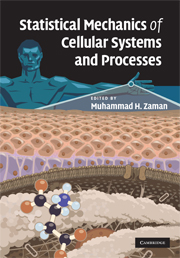Book contents
- Frontmatter
- Contents
- List of contributors
- Preface
- 1 Concentration and crowding effects on protein stability from a coarse-grained model
- 2 Observations on the mechanics of a molecular bond under force
- 3 Statistical thermodynamics of cell–matrix interactions
- 4 Potential landscape theory of cellular networks
- 5 Modeling gene regulatory networks for cell fate specification
- 6 Structural and dynamical properties of cellular and regulatory networks
- 7 Statistical mechanics of the immune response to vaccines
- Index
- Plate section
4 - Potential landscape theory of cellular networks
Published online by Cambridge University Press: 04 September 2009
- Frontmatter
- Contents
- List of contributors
- Preface
- 1 Concentration and crowding effects on protein stability from a coarse-grained model
- 2 Observations on the mechanics of a molecular bond under force
- 3 Statistical thermodynamics of cell–matrix interactions
- 4 Potential landscape theory of cellular networks
- 5 Modeling gene regulatory networks for cell fate specification
- 6 Structural and dynamical properties of cellular and regulatory networks
- 7 Statistical mechanics of the immune response to vaccines
- Index
- Plate section
Summary
Potential landscape and cellular network
To understand the biological function and robustness of the biological networks, it is crucial to uncover the underlying global principle [1–3]. The natures of the biological network have been explored by many experimental techniques [4], due to recent advances in genomics and proteomics. It has been found that biological networks are in general quite robust against genetic and environmental perturbations. Our goal is to understand this.
Bioinformatics studies
There are increasing numbers of studies on the global topological structures of the networks recently from bioinformatics [5–8] as well as from engineering design perspectives [9]. The scale-free properties and architectures for the networks have been elucidated [6–8]. The highly connected nodes in the network essential in keeping the network together might be important for the network's function. However, there have been so far very few studies of why the network should be robust and perform the biological function from the physical point of view [10–21].
Deterministic physical approaches
Theoretical models of the biological networks have often been formulated with a set of deterministic evolution equations either in the Boolean or continuous form [22–25, 34–37]. For cellular networks, they are chemical rate equations. These models are fruitful in exploring the local properties such as local stability of the network, but hard for the global ones.
- Type
- Chapter
- Information
- Statistical Mechanics of Cellular Systems and Processes , pp. 74 - 120Publisher: Cambridge University PressPrint publication year: 2009



